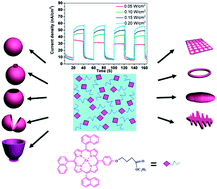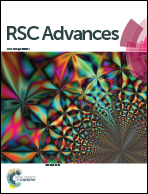Morphology-controlled self-assembled nanostructures of a porphyrin derivative and their photoelectrochemical properties†
Abstract
We have shown that various porphyrin-containing nanostructures can be facilely synthesized by varying the assembly solvent or the temperature in the oil medium, which effectively modulates the evaporation rate and assembly rate of the porphyrin molecules. A dichloromethane solution of 5-(4-(ethylcarboxypropoxy)phenyl)-10,15,20-tri(naphthyl) porphyrin Zn (CTNP–Zn) was injected into a volume of poor solvent and subsequently mixed with a microinjector. The mixture was cast onto the ITO substrate and then left undisturbed to stabilize the nanostructure under different temperature. After the solvent evaporation, diverse CTNP–Zn based nanostructures, including ring-shaped, honey-comb structured, rice-shaped, hollow spherical, urn-shaped, etc., were successfully assembled depending on the solvent composition or the evaporation temperature. The nanostructures have been characterized by electronic absorption, scanning electron microscopy (SEM) and photoelectric conversion techniques. The internal structures of the nanostructures are described by XRD. It is of great significance for the further extending the applications in optic devices.


 Please wait while we load your content...
Please wait while we load your content...